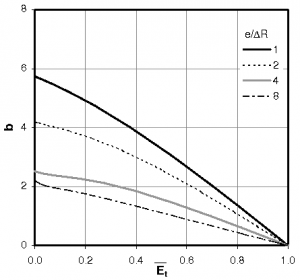Deformation of the seal faces
The second step of the model concerns deformation of the mechanical seal faces. To be able to accurately determine the behavior of the seal it is mandatory to know the geometrical configuration of the seal faces. Usually, the magnitude of the deformations is a couple of microns (Doust and Parmar, 1986) to be compared to the distance between the faces which is of the order of a micron. The model presented here is axisymetric and thus the deformation considered is an angular deformation leading to a conical shape of the faces. It can be measured by mean of a taper or coning angle as illustrated on the next figure.
 Two types of deformation can be identified (Doust and Parmar 1986). The first one is due to thermal gradient in the rings and leads to a coning angle
Two types of deformation can be identified (Doust and Parmar 1986). The first one is due to thermal gradient in the rings and leads to a coning angle . This angle is proportional to the seal face temperature rise
leading to the following rotation:
where is the thermal rotation rate. It is important to note that for many seal rings design, the coefficient
is positive if calculated as indicated on the previous figure.
An additional deformation is due to the mechanical loading generated by the sealed fluid pressure and the springs, O-rings, etc. Unfortunately, there exists no analytical solution of this problem and these angles must be calculated by FEA. However, these coefficients remain constant as long as the boundary conditions are unchanged. For example, the next figure presents the evolution of
as a function of
for a rectangular ring of length
, width
and radii ratio of 0.88. Here
is the thermal expansion coefficient of the material.
 The total coning angle
The total coning angle can be expressed in this way:
Reference
Doust, T. & Parmar, A. An Experimental and Theoretical Study of pressure and thermal Distortions in a Mechanical Seal ASLE Transactions, 1986, 29, 151-159


